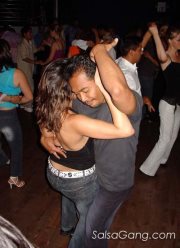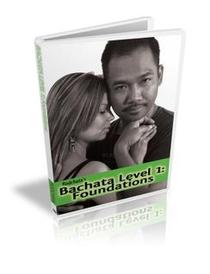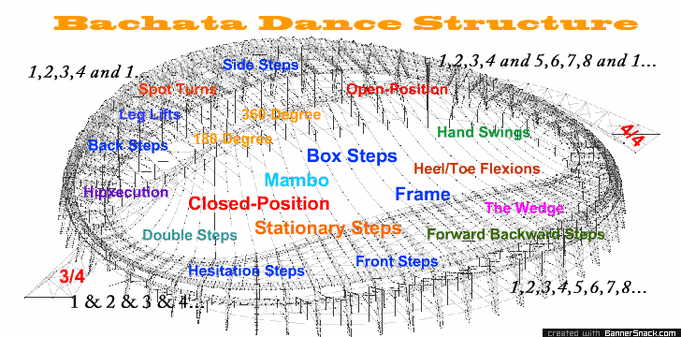
YOU DON'T...
Just like doctors, managers, salespeople, athletes, and any other professionals, they never stop learning. Every year, they are required to get tested and re-certified. Athletes are constantly training and discovering more ways for self-improvement. In fact they pay top dollars for mental coaching.
In bachata, there is a danger of "hey, I don't need anymore lessons" due to the fact that it is such a simple dance with simple moves. However...
Bachata techniques and movements (authentic) are actually difficult to master if you don't have patience. Most students give up and are satisfied with the limited movements they've mastered.
The dance has a lot of short movements, meaning, most of the movements aren't "full range of motion" type i.e., ballroom's figure 8 or electric slide. Mastering short movements takes time to master because they are "dynamic" as opposed to "static." In other words when it comes to muscles being used, bachateros uses Fast Twitch Muscles, particularly, the Type II Fibers.
Is it possible to use both Fast Twitch and and Slow Twitch muscles in bachata? Absolutely, do you ever notice students dancing to the fast Se Te Nota (Joe Veras) easily, yet, when they dance Vivire (Juan Luis Guerra) they have a hard time slowing down and still doing rapid movements? Well...this another topic of article isn't it?
But I digress...
HOW DOES A STUDENT KNOW IF THEY ARE GOOD ENOUGH FOR THE NEXT LEVEL - Intermediate, Advance or even Pro?
There are several ways, actually, and one of them isn't coming from the student. Just because you have taken several lessons, or workshops, doesn't mean you can now qualify yourself as "good enough."
Think about it.
Who determines if you are good enough in academic school? Who decides if you are good enough for a degree? Who decides if you are good enough for a Certification? Who decides if you are good enough to win a competition? Certainly, not you.
Most of the time, your teacher or your coach can tell you what you need to improve if you actually ask them. They will never tell you what they think of your dancing if you never ask. (I personally won't). But if you actually want to really improve, you have to ask but be prepared for constructive criticism which isn't meant to demean or hurt you.
In the old Kung Fu TV Series, remember David Carradine? After a couple of training sessions, he asked his teacher, "teacher, how long will it take for me to be good and when can I leave the Shaolin Temple?" "Snatch this grasshopper out of my hand and when you can do this, you can leave the temple, says master Po" And of course it took him years to be able to do that. It was his master's way of saying, "Ill tell you when you're ready."
Never ask your friends, your boyfriend, your girlfriend if you're good enough. 99% of the time, they don't want to offend you or hurt your feelings. There are a few teachers out there who also don't want to offend you for the fear of losing you as their student - stop learning from them. Learn from the ones that actually cares about the art of dancing and students of dancing.
You can also record yourself social dancing in a video...watch it afterwards and even show it to a person that is a dance expert. Please don't ask your colleagues. Most of the time, they don't want to offend you, or they actually have no clue "what's good or bad."
Nightclub Dance Classes are really not the place to get you better in dancing because the teachers won't be able to give you full attention. Dance Studio classes, although better than nightclub classes, will also not get you better in dancing unless, you constantly and repetitively attend the classes over and over again. You see, there is a difference between taking a class for an hour and training to dance for many hours.
Don't get me wrong, you can learn a move or certain moves in an hour just like I can actually memorize the math's multiplication table in a few hours. But memorizing a move won't make you better in social dancing; training and practicing the moves does.
There is a notion I'd like to debunk, "Practice makes perfect." NO!!! You're missing one word, "GOOD practice makes perfect." A qualified person has to be there to CORRECT you. He will constantly correct you until you bleed.
A good example with this is with Team Rodchata Members (my former dance group). They practiced 3 top 4 hours twice a week (which is not even enough) rehearsing just a few techniques. They were all tough on each other. They lost a lot of weight for hardcore dance training. If one person was lagging in perfecting a movement, one of them would help and paid extra attention with coaching. Team Rodchata dancers might not have been that popular for "performance" on stage, but they certainly built quite a good reputation when it came to social dancing in the Bay Area which is lacking amongst other dance team groups.
Learning from a class or workshop isn't good enough, good training makes you a good dancer.
The bottom line is bachata is a feeling. We all know that mastering your feelings takes time...
Catch Rodchata Dance Classes every Wednesday at Allegro Ballroom, 5855 Christie Ave, Emeryville, CA from 730pm to 930pm - Like His Dance Classes Page Here - https://www.facebook.com/RodchataBachataKizomba
Just like doctors, managers, salespeople, athletes, and any other professionals, they never stop learning. Every year, they are required to get tested and re-certified. Athletes are constantly training and discovering more ways for self-improvement. In fact they pay top dollars for mental coaching.
In bachata, there is a danger of "hey, I don't need anymore lessons" due to the fact that it is such a simple dance with simple moves. However...
Bachata techniques and movements (authentic) are actually difficult to master if you don't have patience. Most students give up and are satisfied with the limited movements they've mastered.
The dance has a lot of short movements, meaning, most of the movements aren't "full range of motion" type i.e., ballroom's figure 8 or electric slide. Mastering short movements takes time to master because they are "dynamic" as opposed to "static." In other words when it comes to muscles being used, bachateros uses Fast Twitch Muscles, particularly, the Type II Fibers.
Is it possible to use both Fast Twitch and and Slow Twitch muscles in bachata? Absolutely, do you ever notice students dancing to the fast Se Te Nota (Joe Veras) easily, yet, when they dance Vivire (Juan Luis Guerra) they have a hard time slowing down and still doing rapid movements? Well...this another topic of article isn't it?
But I digress...
HOW DOES A STUDENT KNOW IF THEY ARE GOOD ENOUGH FOR THE NEXT LEVEL - Intermediate, Advance or even Pro?
There are several ways, actually, and one of them isn't coming from the student. Just because you have taken several lessons, or workshops, doesn't mean you can now qualify yourself as "good enough."
Think about it.
Who determines if you are good enough in academic school? Who decides if you are good enough for a degree? Who decides if you are good enough for a Certification? Who decides if you are good enough to win a competition? Certainly, not you.
Most of the time, your teacher or your coach can tell you what you need to improve if you actually ask them. They will never tell you what they think of your dancing if you never ask. (I personally won't). But if you actually want to really improve, you have to ask but be prepared for constructive criticism which isn't meant to demean or hurt you.
In the old Kung Fu TV Series, remember David Carradine? After a couple of training sessions, he asked his teacher, "teacher, how long will it take for me to be good and when can I leave the Shaolin Temple?" "Snatch this grasshopper out of my hand and when you can do this, you can leave the temple, says master Po" And of course it took him years to be able to do that. It was his master's way of saying, "Ill tell you when you're ready."
Never ask your friends, your boyfriend, your girlfriend if you're good enough. 99% of the time, they don't want to offend you or hurt your feelings. There are a few teachers out there who also don't want to offend you for the fear of losing you as their student - stop learning from them. Learn from the ones that actually cares about the art of dancing and students of dancing.
You can also record yourself social dancing in a video...watch it afterwards and even show it to a person that is a dance expert. Please don't ask your colleagues. Most of the time, they don't want to offend you, or they actually have no clue "what's good or bad."
Nightclub Dance Classes are really not the place to get you better in dancing because the teachers won't be able to give you full attention. Dance Studio classes, although better than nightclub classes, will also not get you better in dancing unless, you constantly and repetitively attend the classes over and over again. You see, there is a difference between taking a class for an hour and training to dance for many hours.
Don't get me wrong, you can learn a move or certain moves in an hour just like I can actually memorize the math's multiplication table in a few hours. But memorizing a move won't make you better in social dancing; training and practicing the moves does.
There is a notion I'd like to debunk, "Practice makes perfect." NO!!! You're missing one word, "GOOD practice makes perfect." A qualified person has to be there to CORRECT you. He will constantly correct you until you bleed.
A good example with this is with Team Rodchata Members (my former dance group). They practiced 3 top 4 hours twice a week (which is not even enough) rehearsing just a few techniques. They were all tough on each other. They lost a lot of weight for hardcore dance training. If one person was lagging in perfecting a movement, one of them would help and paid extra attention with coaching. Team Rodchata dancers might not have been that popular for "performance" on stage, but they certainly built quite a good reputation when it came to social dancing in the Bay Area which is lacking amongst other dance team groups.
Learning from a class or workshop isn't good enough, good training makes you a good dancer.
The bottom line is bachata is a feeling. We all know that mastering your feelings takes time...
Catch Rodchata Dance Classes every Wednesday at Allegro Ballroom, 5855 Christie Ave, Emeryville, CA from 730pm to 930pm - Like His Dance Classes Page Here - https://www.facebook.com/RodchataBachataKizomba




 RSS Feed
RSS Feed
